Building A Sustainable Organisation
VerifiedAdded on 2023/06/12
|10
|2879
|299
AI Summary
This report explores the concept of building a sustainable organization with a focus on electric cars, climate change, and sustainable living practices. It critically evaluates the sustainability of the electric vehicle industry and reflects on ways to comply with sustainability ideals in daily life.
Contribute Materials
Your contribution can guide someone’s learning journey. Share your
documents today.

BUILDING A
SUSTAINABLE
ORGANIZATION
SUSTAINABLE
ORGANIZATION
Secure Best Marks with AI Grader
Need help grading? Try our AI Grader for instant feedback on your assignments.

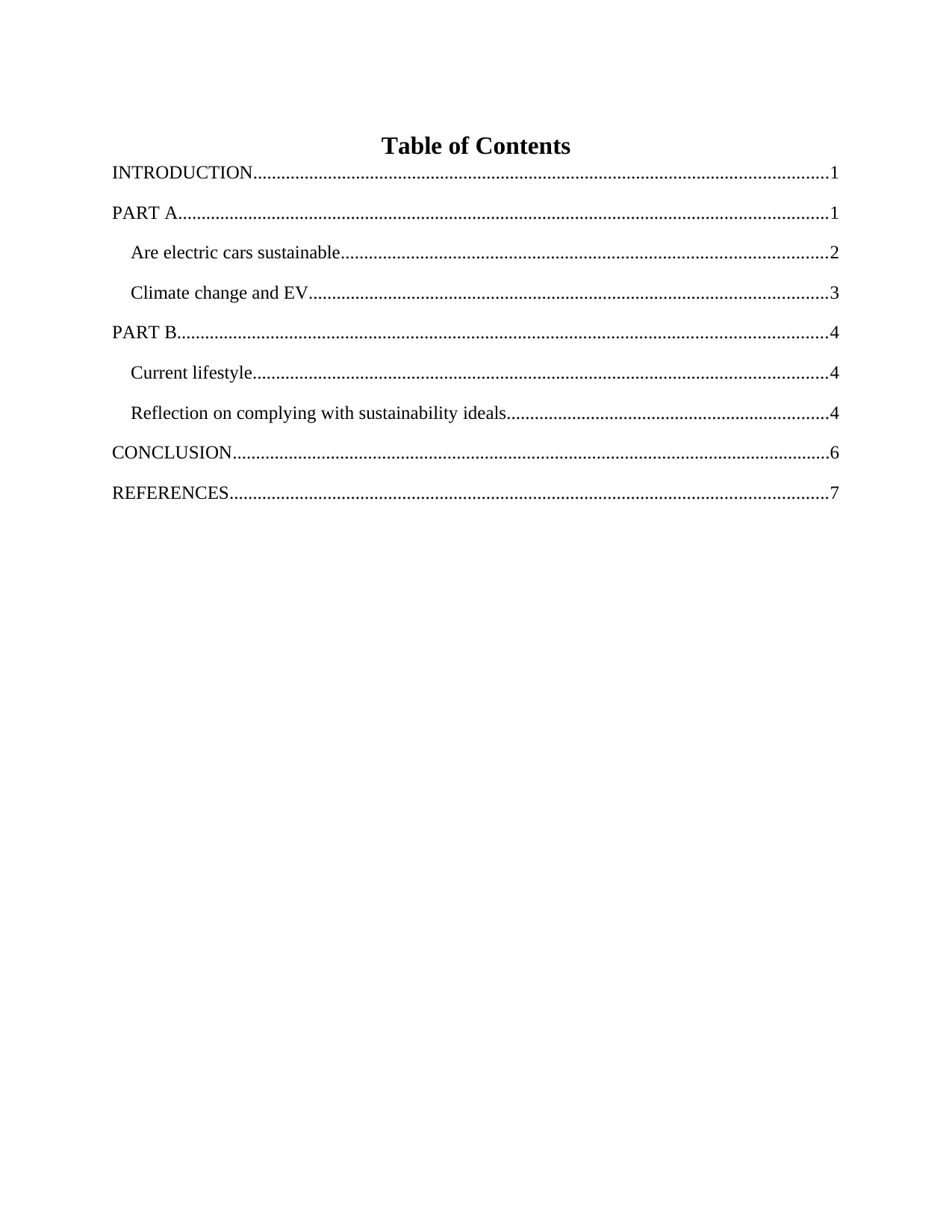
Table of Contents
INTRODUCTION...........................................................................................................................1
PART A...........................................................................................................................................1
Are electric cars sustainable........................................................................................................2
Climate change and EV...............................................................................................................3
PART B...........................................................................................................................................4
Current lifestyle...........................................................................................................................4
Reflection on complying with sustainability ideals.....................................................................4
CONCLUSION................................................................................................................................6
REFERENCES................................................................................................................................7
INTRODUCTION...........................................................................................................................1
PART A...........................................................................................................................................1
Are electric cars sustainable........................................................................................................2
Climate change and EV...............................................................................................................3
PART B...........................................................................................................................................4
Current lifestyle...........................................................................................................................4
Reflection on complying with sustainability ideals.....................................................................4
CONCLUSION................................................................................................................................6
REFERENCES................................................................................................................................7
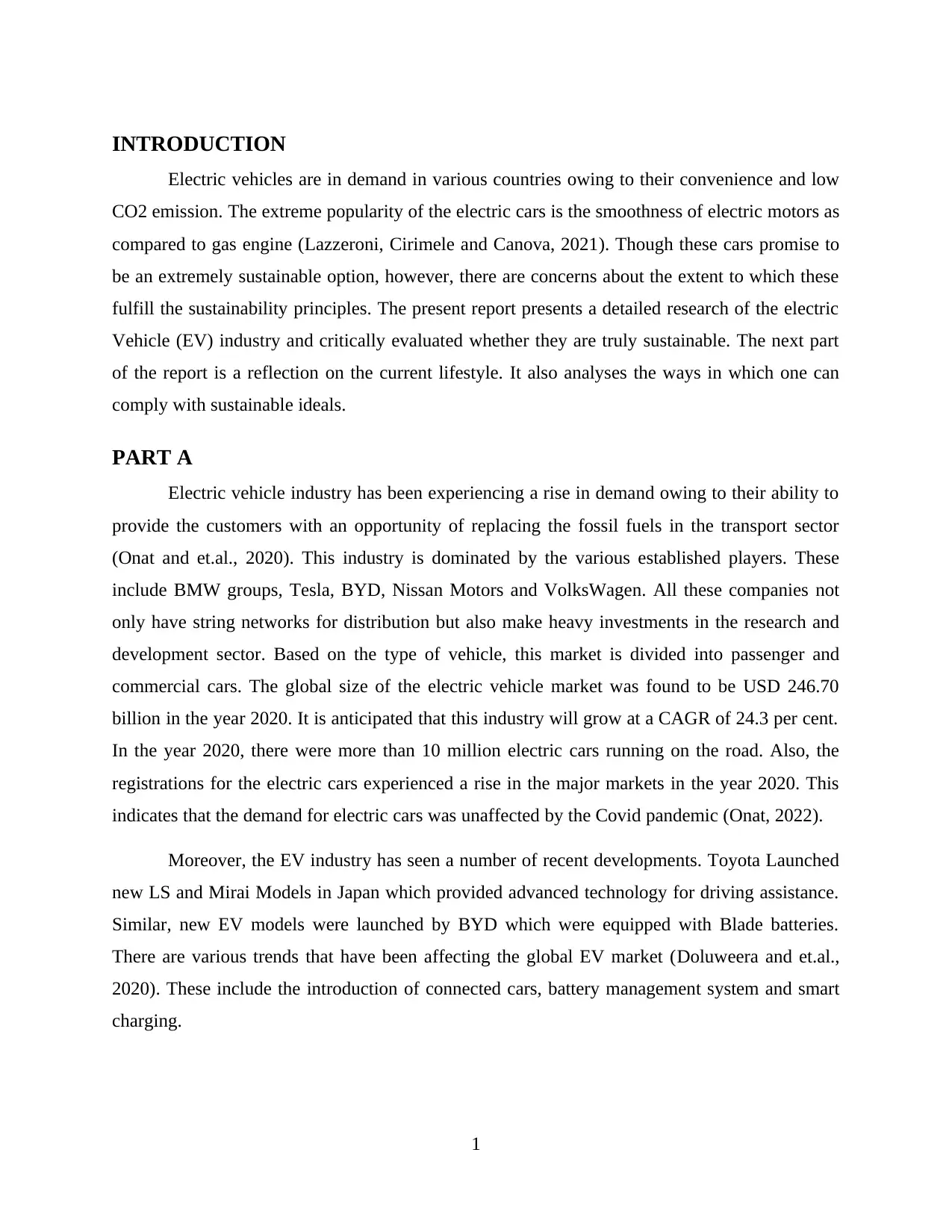
INTRODUCTION
Electric vehicles are in demand in various countries owing to their convenience and low
CO2 emission. The extreme popularity of the electric cars is the smoothness of electric motors as
compared to gas engine (Lazzeroni, Cirimele and Canova, 2021). Though these cars promise to
be an extremely sustainable option, however, there are concerns about the extent to which these
fulfill the sustainability principles. The present report presents a detailed research of the electric
Vehicle (EV) industry and critically evaluated whether they are truly sustainable. The next part
of the report is a reflection on the current lifestyle. It also analyses the ways in which one can
comply with sustainable ideals.
PART A
Electric vehicle industry has been experiencing a rise in demand owing to their ability to
provide the customers with an opportunity of replacing the fossil fuels in the transport sector
(Onat and et.al., 2020). This industry is dominated by the various established players. These
include BMW groups, Tesla, BYD, Nissan Motors and VolksWagen. All these companies not
only have string networks for distribution but also make heavy investments in the research and
development sector. Based on the type of vehicle, this market is divided into passenger and
commercial cars. The global size of the electric vehicle market was found to be USD 246.70
billion in the year 2020. It is anticipated that this industry will grow at a CAGR of 24.3 per cent.
In the year 2020, there were more than 10 million electric cars running on the road. Also, the
registrations for the electric cars experienced a rise in the major markets in the year 2020. This
indicates that the demand for electric cars was unaffected by the Covid pandemic (Onat, 2022).
Moreover, the EV industry has seen a number of recent developments. Toyota Launched
new LS and Mirai Models in Japan which provided advanced technology for driving assistance.
Similar, new EV models were launched by BYD which were equipped with Blade batteries.
There are various trends that have been affecting the global EV market (Doluweera and et.al.,
2020). These include the introduction of connected cars, battery management system and smart
charging.
1
Electric vehicles are in demand in various countries owing to their convenience and low
CO2 emission. The extreme popularity of the electric cars is the smoothness of electric motors as
compared to gas engine (Lazzeroni, Cirimele and Canova, 2021). Though these cars promise to
be an extremely sustainable option, however, there are concerns about the extent to which these
fulfill the sustainability principles. The present report presents a detailed research of the electric
Vehicle (EV) industry and critically evaluated whether they are truly sustainable. The next part
of the report is a reflection on the current lifestyle. It also analyses the ways in which one can
comply with sustainable ideals.
PART A
Electric vehicle industry has been experiencing a rise in demand owing to their ability to
provide the customers with an opportunity of replacing the fossil fuels in the transport sector
(Onat and et.al., 2020). This industry is dominated by the various established players. These
include BMW groups, Tesla, BYD, Nissan Motors and VolksWagen. All these companies not
only have string networks for distribution but also make heavy investments in the research and
development sector. Based on the type of vehicle, this market is divided into passenger and
commercial cars. The global size of the electric vehicle market was found to be USD 246.70
billion in the year 2020. It is anticipated that this industry will grow at a CAGR of 24.3 per cent.
In the year 2020, there were more than 10 million electric cars running on the road. Also, the
registrations for the electric cars experienced a rise in the major markets in the year 2020. This
indicates that the demand for electric cars was unaffected by the Covid pandemic (Onat, 2022).
Moreover, the EV industry has seen a number of recent developments. Toyota Launched
new LS and Mirai Models in Japan which provided advanced technology for driving assistance.
Similar, new EV models were launched by BYD which were equipped with Blade batteries.
There are various trends that have been affecting the global EV market (Doluweera and et.al.,
2020). These include the introduction of connected cars, battery management system and smart
charging.
1
Secure Best Marks with AI Grader
Need help grading? Try our AI Grader for instant feedback on your assignments.
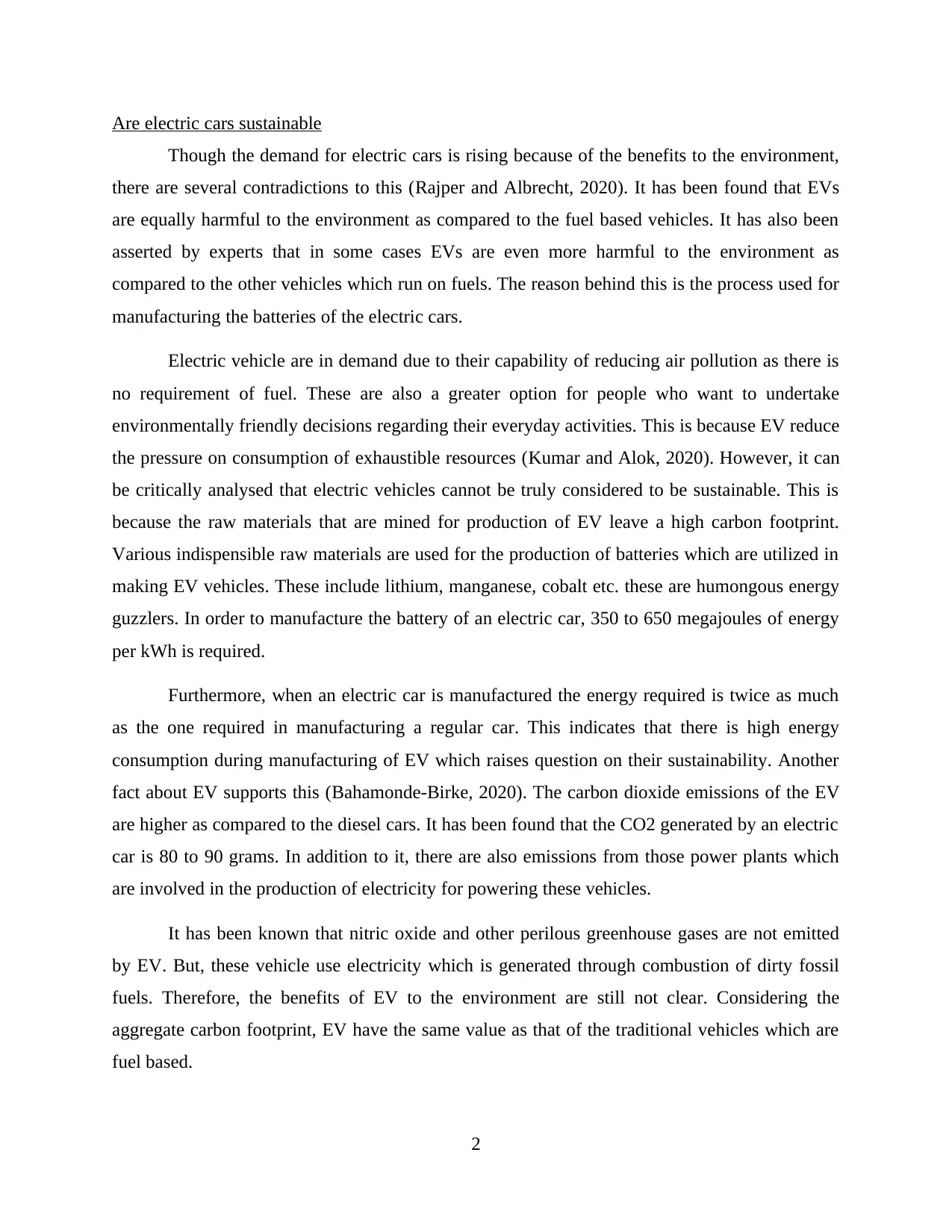
Are electric cars sustainable
Though the demand for electric cars is rising because of the benefits to the environment,
there are several contradictions to this (Rajper and Albrecht, 2020). It has been found that EVs
are equally harmful to the environment as compared to the fuel based vehicles. It has also been
asserted by experts that in some cases EVs are even more harmful to the environment as
compared to the other vehicles which run on fuels. The reason behind this is the process used for
manufacturing the batteries of the electric cars.
Electric vehicle are in demand due to their capability of reducing air pollution as there is
no requirement of fuel. These are also a greater option for people who want to undertake
environmentally friendly decisions regarding their everyday activities. This is because EV reduce
the pressure on consumption of exhaustible resources (Kumar and Alok, 2020). However, it can
be critically analysed that electric vehicles cannot be truly considered to be sustainable. This is
because the raw materials that are mined for production of EV leave a high carbon footprint.
Various indispensible raw materials are used for the production of batteries which are utilized in
making EV vehicles. These include lithium, manganese, cobalt etc. these are humongous energy
guzzlers. In order to manufacture the battery of an electric car, 350 to 650 megajoules of energy
per kWh is required.
Furthermore, when an electric car is manufactured the energy required is twice as much
as the one required in manufacturing a regular car. This indicates that there is high energy
consumption during manufacturing of EV which raises question on their sustainability. Another
fact about EV supports this (Bahamonde-Birke, 2020). The carbon dioxide emissions of the EV
are higher as compared to the diesel cars. It has been found that the CO2 generated by an electric
car is 80 to 90 grams. In addition to it, there are also emissions from those power plants which
are involved in the production of electricity for powering these vehicles.
It has been known that nitric oxide and other perilous greenhouse gases are not emitted
by EV. But, these vehicle use electricity which is generated through combustion of dirty fossil
fuels. Therefore, the benefits of EV to the environment are still not clear. Considering the
aggregate carbon footprint, EV have the same value as that of the traditional vehicles which are
fuel based.
2
Though the demand for electric cars is rising because of the benefits to the environment,
there are several contradictions to this (Rajper and Albrecht, 2020). It has been found that EVs
are equally harmful to the environment as compared to the fuel based vehicles. It has also been
asserted by experts that in some cases EVs are even more harmful to the environment as
compared to the other vehicles which run on fuels. The reason behind this is the process used for
manufacturing the batteries of the electric cars.
Electric vehicle are in demand due to their capability of reducing air pollution as there is
no requirement of fuel. These are also a greater option for people who want to undertake
environmentally friendly decisions regarding their everyday activities. This is because EV reduce
the pressure on consumption of exhaustible resources (Kumar and Alok, 2020). However, it can
be critically analysed that electric vehicles cannot be truly considered to be sustainable. This is
because the raw materials that are mined for production of EV leave a high carbon footprint.
Various indispensible raw materials are used for the production of batteries which are utilized in
making EV vehicles. These include lithium, manganese, cobalt etc. these are humongous energy
guzzlers. In order to manufacture the battery of an electric car, 350 to 650 megajoules of energy
per kWh is required.
Furthermore, when an electric car is manufactured the energy required is twice as much
as the one required in manufacturing a regular car. This indicates that there is high energy
consumption during manufacturing of EV which raises question on their sustainability. Another
fact about EV supports this (Bahamonde-Birke, 2020). The carbon dioxide emissions of the EV
are higher as compared to the diesel cars. It has been found that the CO2 generated by an electric
car is 80 to 90 grams. In addition to it, there are also emissions from those power plants which
are involved in the production of electricity for powering these vehicles.
It has been known that nitric oxide and other perilous greenhouse gases are not emitted
by EV. But, these vehicle use electricity which is generated through combustion of dirty fossil
fuels. Therefore, the benefits of EV to the environment are still not clear. Considering the
aggregate carbon footprint, EV have the same value as that of the traditional vehicles which are
fuel based.
2
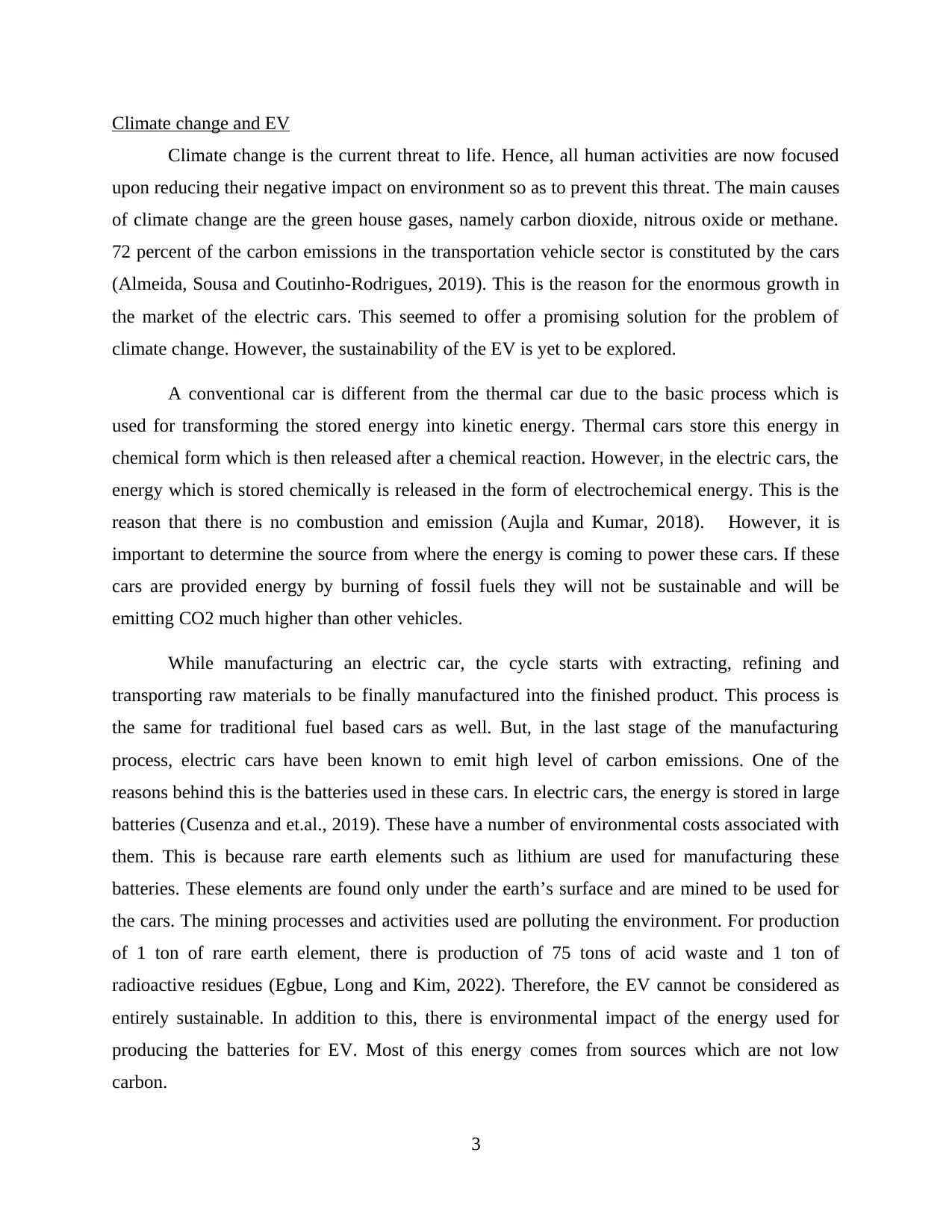
Climate change and EV
Climate change is the current threat to life. Hence, all human activities are now focused
upon reducing their negative impact on environment so as to prevent this threat. The main causes
of climate change are the green house gases, namely carbon dioxide, nitrous oxide or methane.
72 percent of the carbon emissions in the transportation vehicle sector is constituted by the cars
(Almeida, Sousa and Coutinho-Rodrigues, 2019). This is the reason for the enormous growth in
the market of the electric cars. This seemed to offer a promising solution for the problem of
climate change. However, the sustainability of the EV is yet to be explored.
A conventional car is different from the thermal car due to the basic process which is
used for transforming the stored energy into kinetic energy. Thermal cars store this energy in
chemical form which is then released after a chemical reaction. However, in the electric cars, the
energy which is stored chemically is released in the form of electrochemical energy. This is the
reason that there is no combustion and emission (Aujla and Kumar, 2018). However, it is
important to determine the source from where the energy is coming to power these cars. If these
cars are provided energy by burning of fossil fuels they will not be sustainable and will be
emitting CO2 much higher than other vehicles.
While manufacturing an electric car, the cycle starts with extracting, refining and
transporting raw materials to be finally manufactured into the finished product. This process is
the same for traditional fuel based cars as well. But, in the last stage of the manufacturing
process, electric cars have been known to emit high level of carbon emissions. One of the
reasons behind this is the batteries used in these cars. In electric cars, the energy is stored in large
batteries (Cusenza and et.al., 2019). These have a number of environmental costs associated with
them. This is because rare earth elements such as lithium are used for manufacturing these
batteries. These elements are found only under the earth’s surface and are mined to be used for
the cars. The mining processes and activities used are polluting the environment. For production
of 1 ton of rare earth element, there is production of 75 tons of acid waste and 1 ton of
radioactive residues (Egbue, Long and Kim, 2022). Therefore, the EV cannot be considered as
entirely sustainable. In addition to this, there is environmental impact of the energy used for
producing the batteries for EV. Most of this energy comes from sources which are not low
carbon.
3
Climate change is the current threat to life. Hence, all human activities are now focused
upon reducing their negative impact on environment so as to prevent this threat. The main causes
of climate change are the green house gases, namely carbon dioxide, nitrous oxide or methane.
72 percent of the carbon emissions in the transportation vehicle sector is constituted by the cars
(Almeida, Sousa and Coutinho-Rodrigues, 2019). This is the reason for the enormous growth in
the market of the electric cars. This seemed to offer a promising solution for the problem of
climate change. However, the sustainability of the EV is yet to be explored.
A conventional car is different from the thermal car due to the basic process which is
used for transforming the stored energy into kinetic energy. Thermal cars store this energy in
chemical form which is then released after a chemical reaction. However, in the electric cars, the
energy which is stored chemically is released in the form of electrochemical energy. This is the
reason that there is no combustion and emission (Aujla and Kumar, 2018). However, it is
important to determine the source from where the energy is coming to power these cars. If these
cars are provided energy by burning of fossil fuels they will not be sustainable and will be
emitting CO2 much higher than other vehicles.
While manufacturing an electric car, the cycle starts with extracting, refining and
transporting raw materials to be finally manufactured into the finished product. This process is
the same for traditional fuel based cars as well. But, in the last stage of the manufacturing
process, electric cars have been known to emit high level of carbon emissions. One of the
reasons behind this is the batteries used in these cars. In electric cars, the energy is stored in large
batteries (Cusenza and et.al., 2019). These have a number of environmental costs associated with
them. This is because rare earth elements such as lithium are used for manufacturing these
batteries. These elements are found only under the earth’s surface and are mined to be used for
the cars. The mining processes and activities used are polluting the environment. For production
of 1 ton of rare earth element, there is production of 75 tons of acid waste and 1 ton of
radioactive residues (Egbue, Long and Kim, 2022). Therefore, the EV cannot be considered as
entirely sustainable. In addition to this, there is environmental impact of the energy used for
producing the batteries for EV. Most of this energy comes from sources which are not low
carbon.
3
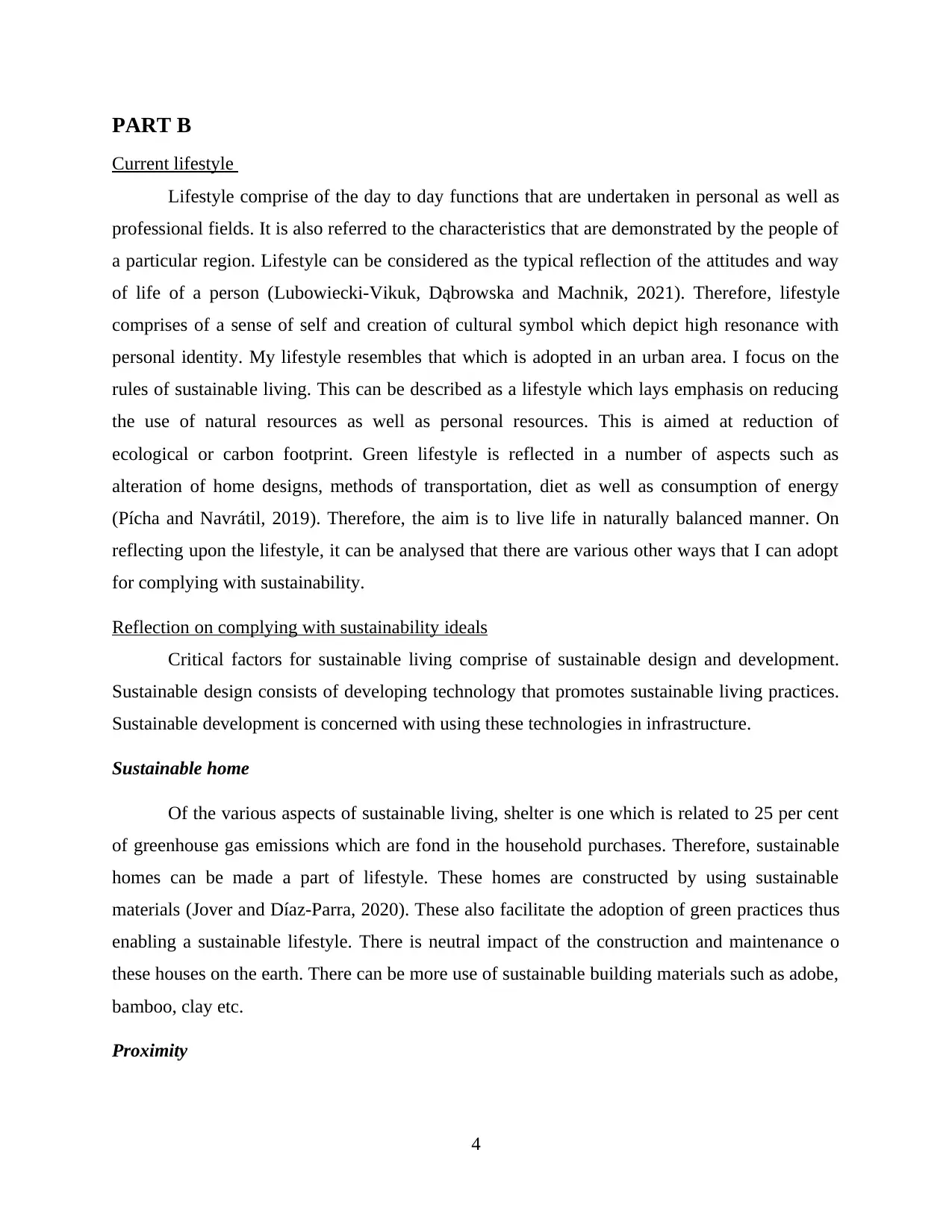
PART B
Current lifestyle
Lifestyle comprise of the day to day functions that are undertaken in personal as well as
professional fields. It is also referred to the characteristics that are demonstrated by the people of
a particular region. Lifestyle can be considered as the typical reflection of the attitudes and way
of life of a person (Lubowiecki-Vikuk, Dąbrowska and Machnik, 2021). Therefore, lifestyle
comprises of a sense of self and creation of cultural symbol which depict high resonance with
personal identity. My lifestyle resembles that which is adopted in an urban area. I focus on the
rules of sustainable living. This can be described as a lifestyle which lays emphasis on reducing
the use of natural resources as well as personal resources. This is aimed at reduction of
ecological or carbon footprint. Green lifestyle is reflected in a number of aspects such as
alteration of home designs, methods of transportation, diet as well as consumption of energy
(Pícha and Navrátil, 2019). Therefore, the aim is to live life in naturally balanced manner. On
reflecting upon the lifestyle, it can be analysed that there are various other ways that I can adopt
for complying with sustainability.
Reflection on complying with sustainability ideals
Critical factors for sustainable living comprise of sustainable design and development.
Sustainable design consists of developing technology that promotes sustainable living practices.
Sustainable development is concerned with using these technologies in infrastructure.
Sustainable home
Of the various aspects of sustainable living, shelter is one which is related to 25 per cent
of greenhouse gas emissions which are fond in the household purchases. Therefore, sustainable
homes can be made a part of lifestyle. These homes are constructed by using sustainable
materials (Jover and Díaz-Parra, 2020). These also facilitate the adoption of green practices thus
enabling a sustainable lifestyle. There is neutral impact of the construction and maintenance o
these houses on the earth. There can be more use of sustainable building materials such as adobe,
bamboo, clay etc.
Proximity
4
Current lifestyle
Lifestyle comprise of the day to day functions that are undertaken in personal as well as
professional fields. It is also referred to the characteristics that are demonstrated by the people of
a particular region. Lifestyle can be considered as the typical reflection of the attitudes and way
of life of a person (Lubowiecki-Vikuk, Dąbrowska and Machnik, 2021). Therefore, lifestyle
comprises of a sense of self and creation of cultural symbol which depict high resonance with
personal identity. My lifestyle resembles that which is adopted in an urban area. I focus on the
rules of sustainable living. This can be described as a lifestyle which lays emphasis on reducing
the use of natural resources as well as personal resources. This is aimed at reduction of
ecological or carbon footprint. Green lifestyle is reflected in a number of aspects such as
alteration of home designs, methods of transportation, diet as well as consumption of energy
(Pícha and Navrátil, 2019). Therefore, the aim is to live life in naturally balanced manner. On
reflecting upon the lifestyle, it can be analysed that there are various other ways that I can adopt
for complying with sustainability.
Reflection on complying with sustainability ideals
Critical factors for sustainable living comprise of sustainable design and development.
Sustainable design consists of developing technology that promotes sustainable living practices.
Sustainable development is concerned with using these technologies in infrastructure.
Sustainable home
Of the various aspects of sustainable living, shelter is one which is related to 25 per cent
of greenhouse gas emissions which are fond in the household purchases. Therefore, sustainable
homes can be made a part of lifestyle. These homes are constructed by using sustainable
materials (Jover and Díaz-Parra, 2020). These also facilitate the adoption of green practices thus
enabling a sustainable lifestyle. There is neutral impact of the construction and maintenance o
these houses on the earth. There can be more use of sustainable building materials such as adobe,
bamboo, clay etc.
Proximity
4
Paraphrase This Document
Need a fresh take? Get an instant paraphrase of this document with our AI Paraphraser
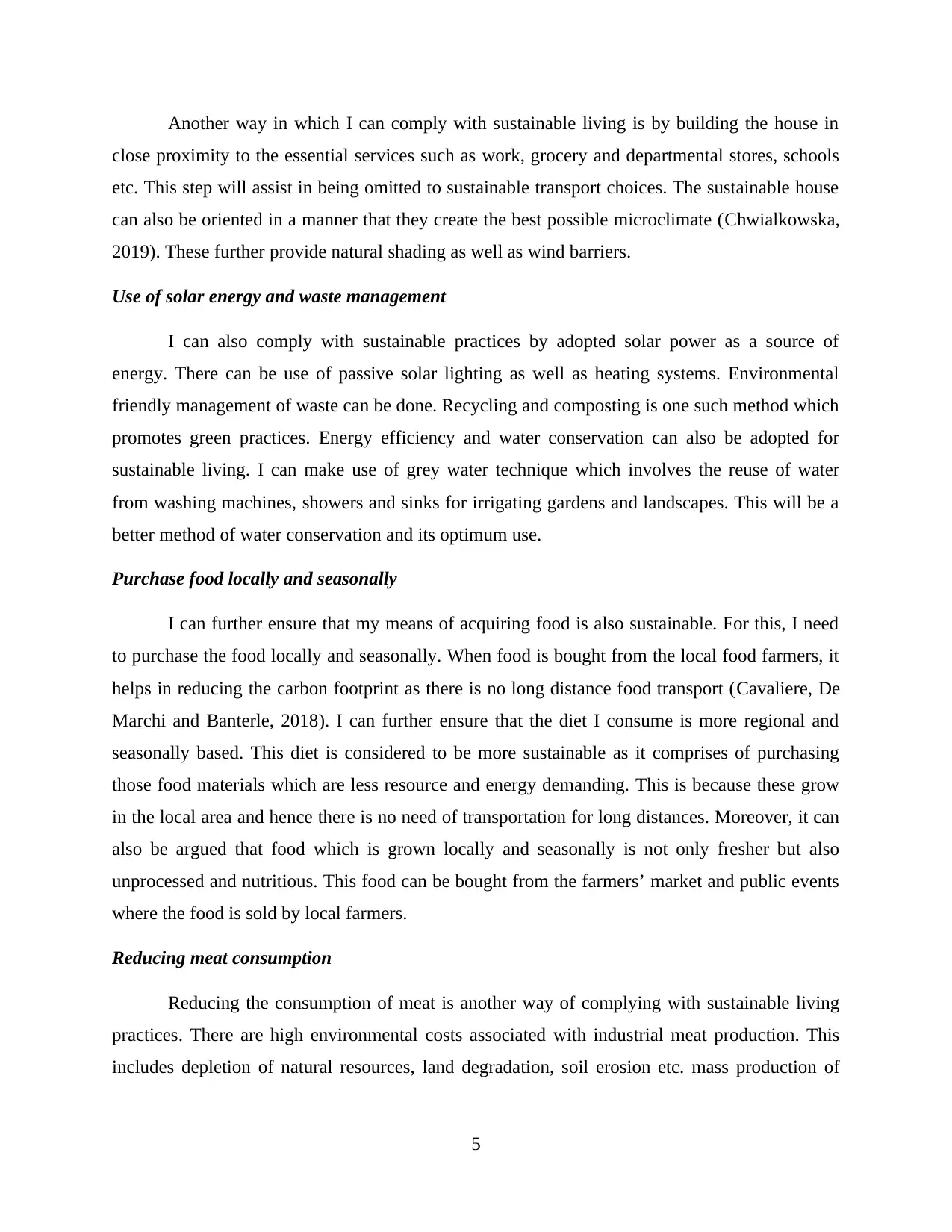
Another way in which I can comply with sustainable living is by building the house in
close proximity to the essential services such as work, grocery and departmental stores, schools
etc. This step will assist in being omitted to sustainable transport choices. The sustainable house
can also be oriented in a manner that they create the best possible microclimate (Chwialkowska,
2019). These further provide natural shading as well as wind barriers.
Use of solar energy and waste management
I can also comply with sustainable practices by adopted solar power as a source of
energy. There can be use of passive solar lighting as well as heating systems. Environmental
friendly management of waste can be done. Recycling and composting is one such method which
promotes green practices. Energy efficiency and water conservation can also be adopted for
sustainable living. I can make use of grey water technique which involves the reuse of water
from washing machines, showers and sinks for irrigating gardens and landscapes. This will be a
better method of water conservation and its optimum use.
Purchase food locally and seasonally
I can further ensure that my means of acquiring food is also sustainable. For this, I need
to purchase the food locally and seasonally. When food is bought from the local food farmers, it
helps in reducing the carbon footprint as there is no long distance food transport (Cavaliere, De
Marchi and Banterle, 2018). I can further ensure that the diet I consume is more regional and
seasonally based. This diet is considered to be more sustainable as it comprises of purchasing
those food materials which are less resource and energy demanding. This is because these grow
in the local area and hence there is no need of transportation for long distances. Moreover, it can
also be argued that food which is grown locally and seasonally is not only fresher but also
unprocessed and nutritious. This food can be bought from the farmers’ market and public events
where the food is sold by local farmers.
Reducing meat consumption
Reducing the consumption of meat is another way of complying with sustainable living
practices. There are high environmental costs associated with industrial meat production. This
includes depletion of natural resources, land degradation, soil erosion etc. mass production of
5
close proximity to the essential services such as work, grocery and departmental stores, schools
etc. This step will assist in being omitted to sustainable transport choices. The sustainable house
can also be oriented in a manner that they create the best possible microclimate (Chwialkowska,
2019). These further provide natural shading as well as wind barriers.
Use of solar energy and waste management
I can also comply with sustainable practices by adopted solar power as a source of
energy. There can be use of passive solar lighting as well as heating systems. Environmental
friendly management of waste can be done. Recycling and composting is one such method which
promotes green practices. Energy efficiency and water conservation can also be adopted for
sustainable living. I can make use of grey water technique which involves the reuse of water
from washing machines, showers and sinks for irrigating gardens and landscapes. This will be a
better method of water conservation and its optimum use.
Purchase food locally and seasonally
I can further ensure that my means of acquiring food is also sustainable. For this, I need
to purchase the food locally and seasonally. When food is bought from the local food farmers, it
helps in reducing the carbon footprint as there is no long distance food transport (Cavaliere, De
Marchi and Banterle, 2018). I can further ensure that the diet I consume is more regional and
seasonally based. This diet is considered to be more sustainable as it comprises of purchasing
those food materials which are less resource and energy demanding. This is because these grow
in the local area and hence there is no need of transportation for long distances. Moreover, it can
also be argued that food which is grown locally and seasonally is not only fresher but also
unprocessed and nutritious. This food can be bought from the farmers’ market and public events
where the food is sold by local farmers.
Reducing meat consumption
Reducing the consumption of meat is another way of complying with sustainable living
practices. There are high environmental costs associated with industrial meat production. This
includes depletion of natural resources, land degradation, soil erosion etc. mass production of
5
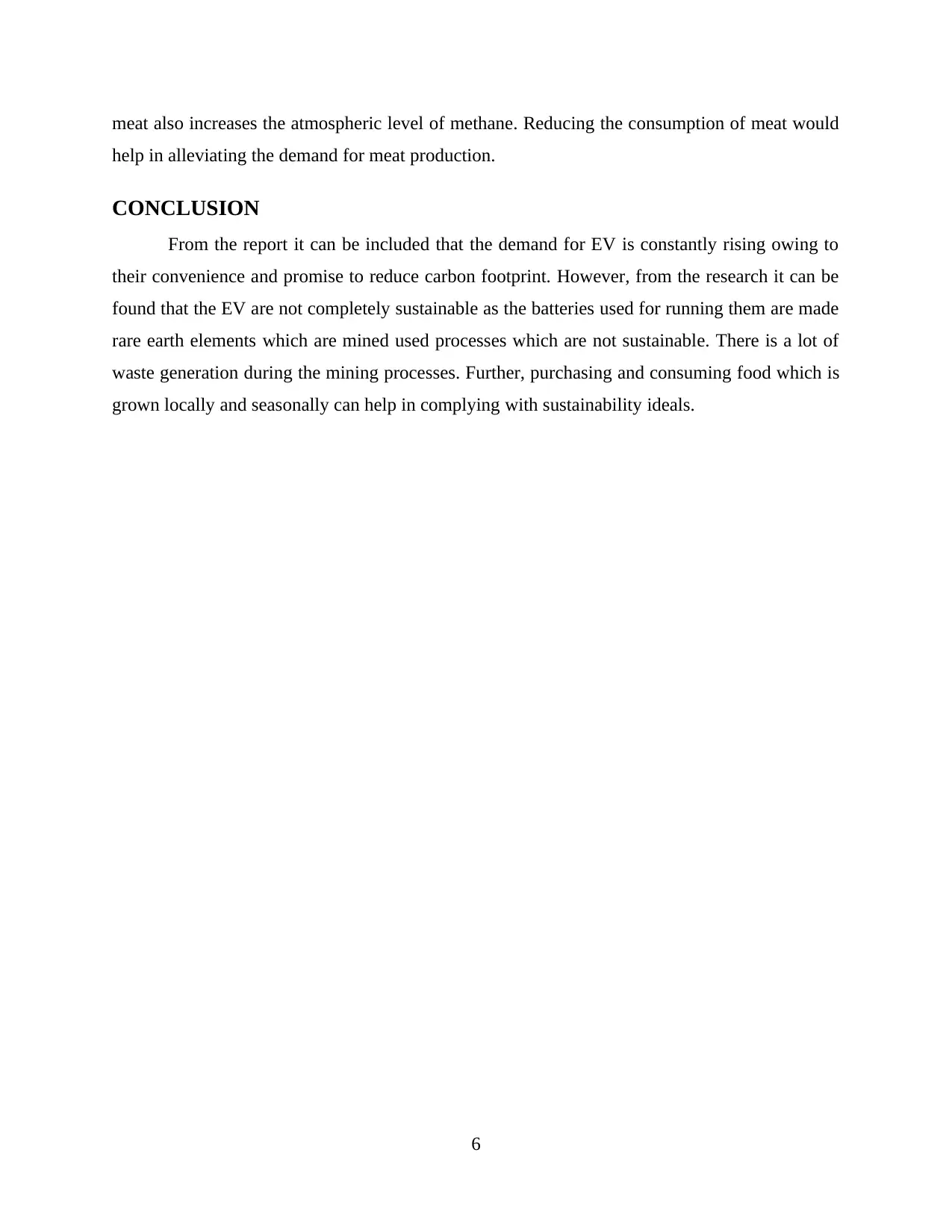
meat also increases the atmospheric level of methane. Reducing the consumption of meat would
help in alleviating the demand for meat production.
CONCLUSION
From the report it can be included that the demand for EV is constantly rising owing to
their convenience and promise to reduce carbon footprint. However, from the research it can be
found that the EV are not completely sustainable as the batteries used for running them are made
rare earth elements which are mined used processes which are not sustainable. There is a lot of
waste generation during the mining processes. Further, purchasing and consuming food which is
grown locally and seasonally can help in complying with sustainability ideals.
6
help in alleviating the demand for meat production.
CONCLUSION
From the report it can be included that the demand for EV is constantly rising owing to
their convenience and promise to reduce carbon footprint. However, from the research it can be
found that the EV are not completely sustainable as the batteries used for running them are made
rare earth elements which are mined used processes which are not sustainable. There is a lot of
waste generation during the mining processes. Further, purchasing and consuming food which is
grown locally and seasonally can help in complying with sustainability ideals.
6
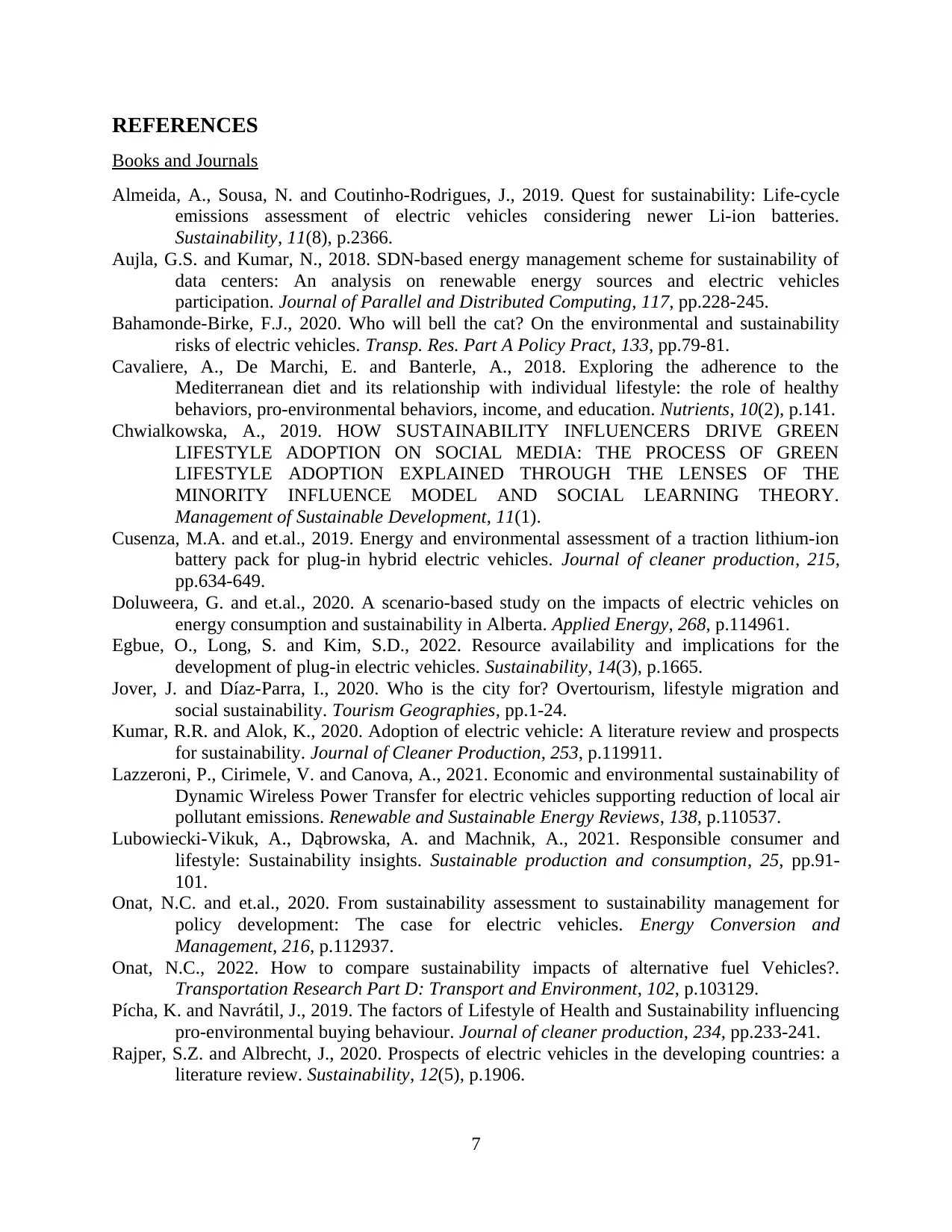
REFERENCES
Books and Journals
Almeida, A., Sousa, N. and Coutinho-Rodrigues, J., 2019. Quest for sustainability: Life-cycle
emissions assessment of electric vehicles considering newer Li-ion batteries.
Sustainability, 11(8), p.2366.
Aujla, G.S. and Kumar, N., 2018. SDN-based energy management scheme for sustainability of
data centers: An analysis on renewable energy sources and electric vehicles
participation. Journal of Parallel and Distributed Computing, 117, pp.228-245.
Bahamonde-Birke, F.J., 2020. Who will bell the cat? On the environmental and sustainability
risks of electric vehicles. Transp. Res. Part A Policy Pract, 133, pp.79-81.
Cavaliere, A., De Marchi, E. and Banterle, A., 2018. Exploring the adherence to the
Mediterranean diet and its relationship with individual lifestyle: the role of healthy
behaviors, pro-environmental behaviors, income, and education. Nutrients, 10(2), p.141.
Chwialkowska, A., 2019. HOW SUSTAINABILITY INFLUENCERS DRIVE GREEN
LIFESTYLE ADOPTION ON SOCIAL MEDIA: THE PROCESS OF GREEN
LIFESTYLE ADOPTION EXPLAINED THROUGH THE LENSES OF THE
MINORITY INFLUENCE MODEL AND SOCIAL LEARNING THEORY.
Management of Sustainable Development, 11(1).
Cusenza, M.A. and et.al., 2019. Energy and environmental assessment of a traction lithium-ion
battery pack for plug-in hybrid electric vehicles. Journal of cleaner production, 215,
pp.634-649.
Doluweera, G. and et.al., 2020. A scenario-based study on the impacts of electric vehicles on
energy consumption and sustainability in Alberta. Applied Energy, 268, p.114961.
Egbue, O., Long, S. and Kim, S.D., 2022. Resource availability and implications for the
development of plug-in electric vehicles. Sustainability, 14(3), p.1665.
Jover, J. and Díaz-Parra, I., 2020. Who is the city for? Overtourism, lifestyle migration and
social sustainability. Tourism Geographies, pp.1-24.
Kumar, R.R. and Alok, K., 2020. Adoption of electric vehicle: A literature review and prospects
for sustainability. Journal of Cleaner Production, 253, p.119911.
Lazzeroni, P., Cirimele, V. and Canova, A., 2021. Economic and environmental sustainability of
Dynamic Wireless Power Transfer for electric vehicles supporting reduction of local air
pollutant emissions. Renewable and Sustainable Energy Reviews, 138, p.110537.
Lubowiecki-Vikuk, A., Dąbrowska, A. and Machnik, A., 2021. Responsible consumer and
lifestyle: Sustainability insights. Sustainable production and consumption, 25, pp.91-
101.
Onat, N.C. and et.al., 2020. From sustainability assessment to sustainability management for
policy development: The case for electric vehicles. Energy Conversion and
Management, 216, p.112937.
Onat, N.C., 2022. How to compare sustainability impacts of alternative fuel Vehicles?.
Transportation Research Part D: Transport and Environment, 102, p.103129.
Pícha, K. and Navrátil, J., 2019. The factors of Lifestyle of Health and Sustainability influencing
pro-environmental buying behaviour. Journal of cleaner production, 234, pp.233-241.
Rajper, S.Z. and Albrecht, J., 2020. Prospects of electric vehicles in the developing countries: a
literature review. Sustainability, 12(5), p.1906.
7
Books and Journals
Almeida, A., Sousa, N. and Coutinho-Rodrigues, J., 2019. Quest for sustainability: Life-cycle
emissions assessment of electric vehicles considering newer Li-ion batteries.
Sustainability, 11(8), p.2366.
Aujla, G.S. and Kumar, N., 2018. SDN-based energy management scheme for sustainability of
data centers: An analysis on renewable energy sources and electric vehicles
participation. Journal of Parallel and Distributed Computing, 117, pp.228-245.
Bahamonde-Birke, F.J., 2020. Who will bell the cat? On the environmental and sustainability
risks of electric vehicles. Transp. Res. Part A Policy Pract, 133, pp.79-81.
Cavaliere, A., De Marchi, E. and Banterle, A., 2018. Exploring the adherence to the
Mediterranean diet and its relationship with individual lifestyle: the role of healthy
behaviors, pro-environmental behaviors, income, and education. Nutrients, 10(2), p.141.
Chwialkowska, A., 2019. HOW SUSTAINABILITY INFLUENCERS DRIVE GREEN
LIFESTYLE ADOPTION ON SOCIAL MEDIA: THE PROCESS OF GREEN
LIFESTYLE ADOPTION EXPLAINED THROUGH THE LENSES OF THE
MINORITY INFLUENCE MODEL AND SOCIAL LEARNING THEORY.
Management of Sustainable Development, 11(1).
Cusenza, M.A. and et.al., 2019. Energy and environmental assessment of a traction lithium-ion
battery pack for plug-in hybrid electric vehicles. Journal of cleaner production, 215,
pp.634-649.
Doluweera, G. and et.al., 2020. A scenario-based study on the impacts of electric vehicles on
energy consumption and sustainability in Alberta. Applied Energy, 268, p.114961.
Egbue, O., Long, S. and Kim, S.D., 2022. Resource availability and implications for the
development of plug-in electric vehicles. Sustainability, 14(3), p.1665.
Jover, J. and Díaz-Parra, I., 2020. Who is the city for? Overtourism, lifestyle migration and
social sustainability. Tourism Geographies, pp.1-24.
Kumar, R.R. and Alok, K., 2020. Adoption of electric vehicle: A literature review and prospects
for sustainability. Journal of Cleaner Production, 253, p.119911.
Lazzeroni, P., Cirimele, V. and Canova, A., 2021. Economic and environmental sustainability of
Dynamic Wireless Power Transfer for electric vehicles supporting reduction of local air
pollutant emissions. Renewable and Sustainable Energy Reviews, 138, p.110537.
Lubowiecki-Vikuk, A., Dąbrowska, A. and Machnik, A., 2021. Responsible consumer and
lifestyle: Sustainability insights. Sustainable production and consumption, 25, pp.91-
101.
Onat, N.C. and et.al., 2020. From sustainability assessment to sustainability management for
policy development: The case for electric vehicles. Energy Conversion and
Management, 216, p.112937.
Onat, N.C., 2022. How to compare sustainability impacts of alternative fuel Vehicles?.
Transportation Research Part D: Transport and Environment, 102, p.103129.
Pícha, K. and Navrátil, J., 2019. The factors of Lifestyle of Health and Sustainability influencing
pro-environmental buying behaviour. Journal of cleaner production, 234, pp.233-241.
Rajper, S.Z. and Albrecht, J., 2020. Prospects of electric vehicles in the developing countries: a
literature review. Sustainability, 12(5), p.1906.
7
1 out of 10
Related Documents
Your All-in-One AI-Powered Toolkit for Academic Success.
+13062052269
info@desklib.com
Available 24*7 on WhatsApp / Email
![[object Object]](/_next/static/media/star-bottom.7253800d.svg)
Unlock your academic potential
© 2024 | Zucol Services PVT LTD | All rights reserved.




